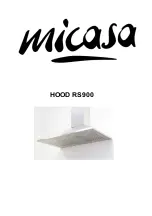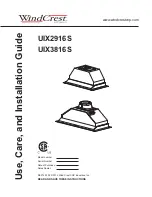
1-6
POWER SUPPLY CORD METHOD
This appliance is manufactured with the neutral
terminal connected to the cabinet. Use a 3-wire,
U.L.-listed, 40-ampere power supply cord. If local
codes do not permit grounding through the neutral,
use a 4-wire power supply cord rated at 250 volts,
40-amperes. Use only ring-type terminals to con-
nect the power supply cord to the terminal block.
1.
Turn off the power to the main supply.
2.
If the opening is not large enough, remove the
knockout for the power supply cord.
3.
Mount a U.L.-listed strain relief in the knock-
out opening.
4.
Insert the power supply cord through the
strain relief, and allow enough slack to easily
attach the wiring to the terminal block, then
tighten the strain relief screws.
remove ring for
40-ampere
power cord
and U.L.-listed
strain relief
opening for
conduit
connector
Proceed to the next page and complete the electri-
cal connections according to the type of electrical
supply cord you are using (“3-Wire Electrical Con-
nections” or “4-Wire Electrical Connections.”).
DIRECT WIRE METHOD
This appliance is manufactured with the neutral
terminal connected to the cabinet. Use a 3-wire,
U.L.-listed, 40-ampere power supply cord. If local
codes do not permit grounding through the neutral,
use a 4-wire power supply cord rated at 250 volts,
40-amperes.
This appliance can be connected directly to the
fuse disconnect, to a circuit breaker box, or with a
U.L.-listed, 40-ampere range power supply cord
with pigtail wires. To prepare the pigtail wires for
connection to the terminal block screws, perform
the following steps.
1.
Turn off the power to the main supply.
2.
Remove the knockout for the power supply
cable.
3.
Mount a U.L.-listed conduit connector in the
power supply cable knockout opening.
U.L.-listed
conduit connector
4.
Strip 3-inches of the outer covering from the
end of the power supply cable and expose the
wires.
5.
Strip 1-inch of insulation from the end of each
of the wires.
6.
Form the bare wires into “U”-shaped hooks.
7.
Insert the power supply cable through the
conduit connector. Allow enough slack so that
you can easily attach the power supply cord
wiring to the terminal block screws, then tighten
the locking ring and clamping screws on the
conduit connector.
Proceed to the next page and complete the electri-
cal connections according to the type of power
supply cable you are using (“3-Wire Electrical
Connections” or “4-Wire Electrical Connections.”).













































